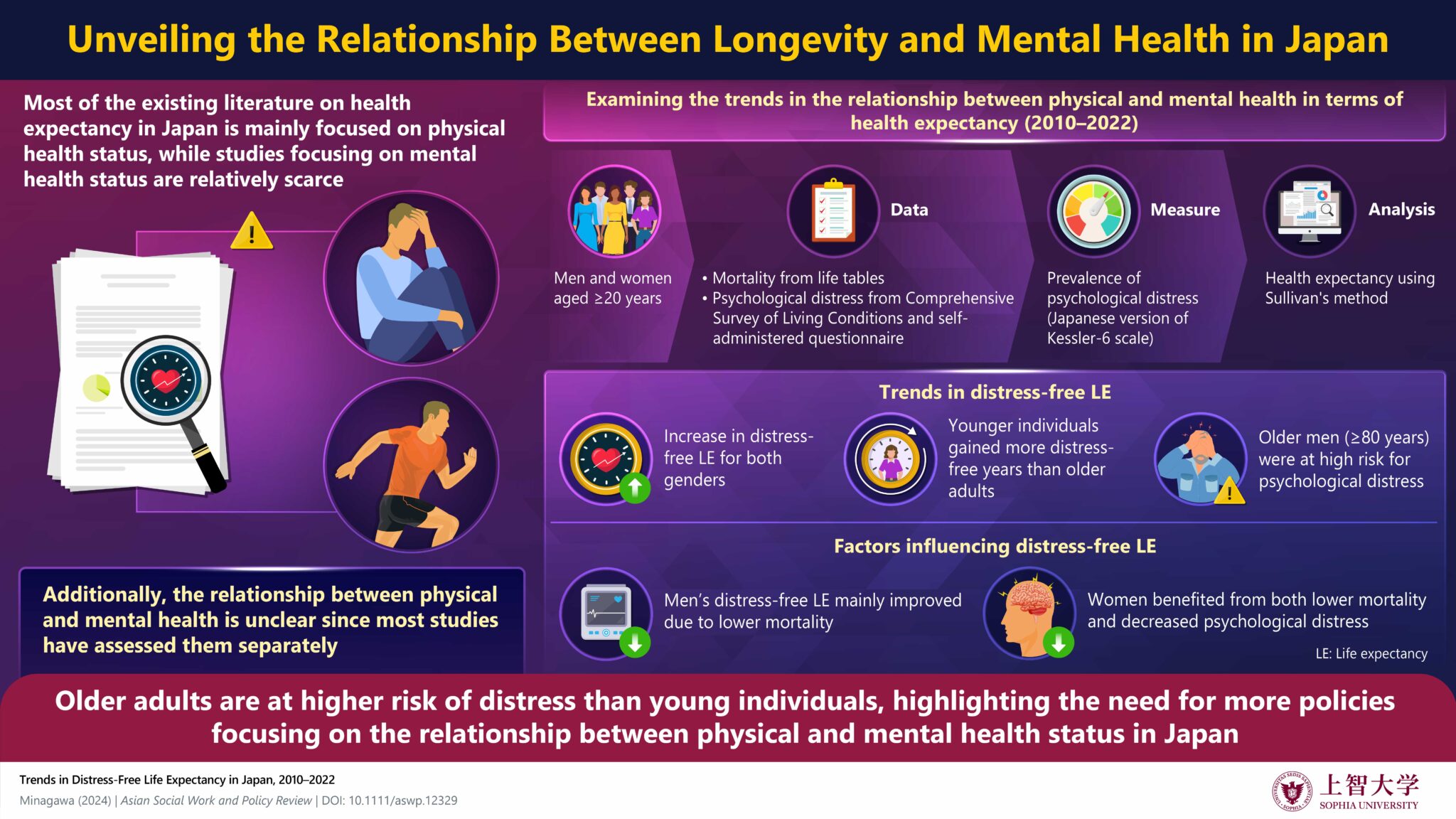Beyond Longevity: The Critical Role of Mental Health in Japan’s Well-Being
Researchers shed light on life expectancy free of psychological distress in Japan to understand the population’s overall health
Most studies on the Japanese population focus on physical rather than mental health. Now, researchers have assessed the trends in the relationship between physical and mental health in Japan using the concept of health expectancy.
The findings reveal substantial improvements in distress-free life expectancy for men and women between 2010 and 2022, with younger individuals benefiting more than older adults, highlighting the need for policies to improve mental well-being for this demographic group.
The Japanese population is known for its longest life expectancy (LE) at birth. Extensive studies have been conducted on the physical health of the Japanese population, mainly on mortality outcomes. However, research on mental health is limited due to the social stigma against mental illnesses. This is alarming since mental health problems such as anxiety, substance use disorders, and suicide rates have largely increased over the years.
Additionally, previous studies have examined the physical and mental health of the Japanese population separately, which makes it harder to understand the relationship between them.
Against this backdrop, Associate Professor Yuka Minagawa from the Faculty of Liberal Arts, Sophia University, assessed the trends in the relationship between physical and mental health in terms of health expectancy—the average number of years a person is likely to live in a specific state of health—among the Japanese population between 2010 and 2022. Notably, this study is the first to use psychological distress data to compute health expectancy in Japan. The findings were published in the Asian Social Work and Policy Review on 3 September 2024.
Highlighting the rationale behind the study, Dr. Minagawa says, “While the concept of health expectancy has been gaining attention as a comprehensive measurement of population health status, most studies in Japan have focused only on physical health indicators and overlooked the role of mental health. This study addresses this gap by estimating the length of life free of psychological distress.”
To this end, mortality data was extracted from life tables published by the Ministry of Health, Labor, and Welfare (MHLW), and psychological distress data was taken from the Comprehensive Survey of Living Conditions (CSLC), also conducted by the MHLW. The prevalence of psychological distress was measured using the Japanese version of the Kessler Psychological Distress Scale 6. Sullivan’s method was then used to combine these data and calculate health expectancy among men and women aged 20 years or above.
The findings revealed that both men and women experienced substantial improvements in distress-free LE, with younger individuals benefiting the most. However, older adults,particularly men, were more likely to experience distress due to various reasons, including widowhood. Dr. Minagawa says, “Widowhood adversely affects men’s mental health, which leads to psychological distress and depression since they must adapt to lifestyle changes without spousal support.”
Initially, distress-free LE decreased for men and women of all ages between 2010 and 2013, likely due to psychosocial stressors such as the 2011 Great East Japan Earthquake and Tsunami. However, it improved through 2022. This increase in distress-free LE from 2019 to 2022, despite the COVID-19 pandemic, does not imply that the mental health of the Japanese population was unaffected.
Differences in distress-free LE between 2010 and 2022 were also analyzed to understand the extent to which they were caused by changes in age-specific mortality rates and the prevalence of psychological distress. Among men across all ages, changes in mortality had a more positive impact on distress-free LE than changes in psychological distress.However, among women, both changes in mortality and psychological distress contributed to improvements in distress-free LE.
These findings highlight the need for targeted interventions to support mental health in Japan. Dr. Minagawa says, “The study improves our understanding of population health by highlighting the crucial role of mental health in the overall well-being of the population. As the prevalence of mental health issues increases, policymakers must focus on the complex relationship between physical and mental health in contemporary Japan.”
Reference
- Title of original paper
Trends in Distress-Free Life Expectancy in Japan, 2010–2022
- Journal
Asian Social Work and Policy Review
- Authors
Yuka Minagawa
- Affiliations
Faculty of Liberal Arts, Sophia University, Japan
About Associate Professor Yuka Minagawa
Dr. Yuka Minagawa is an Associate Professor at the Faculty of Liberal Arts, Sophia University. She received her Ph.D. from the University of Texas at Austin. Her research focuses on social demography, health, aging, and the health impacts of socio-economic transitions in East Central Europe, the former Soviet Union, and Japan. Dr. Minagawa has authored over 20 publications and has been awarded the Nakayama Foundation for Human Science Award in 2023 and the Catholic Academic Research Encouragement Award in 2024. She is a member of the Population Association of Japan and the Population Association of America.
Media Contact
Office of Public Relations, Sophia University
sophiapr-co@sophia.ac.jp
